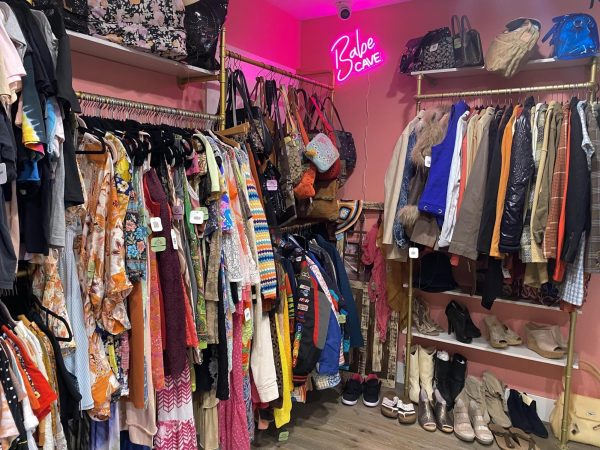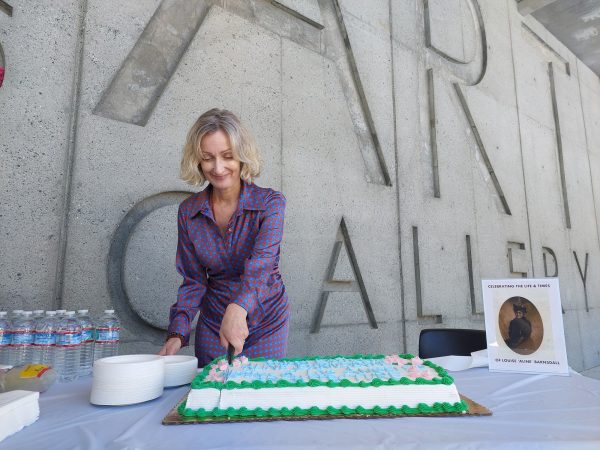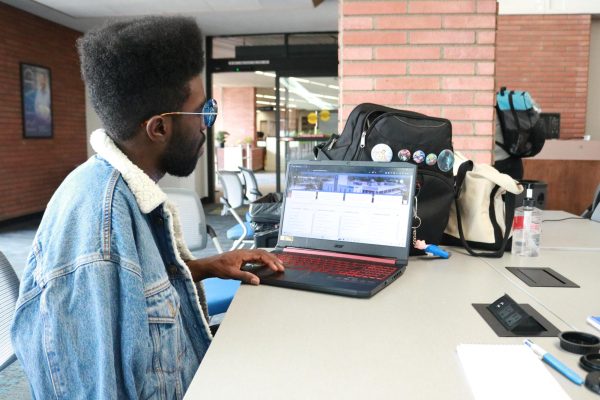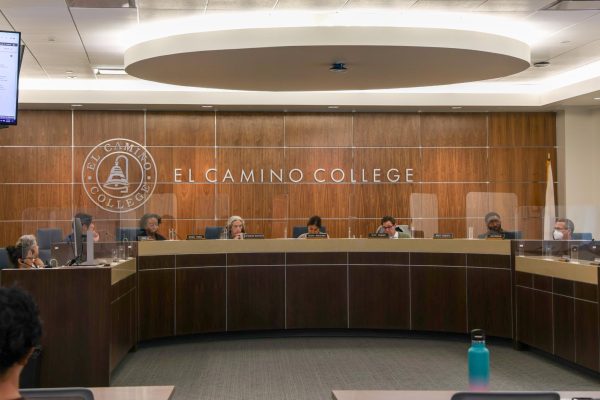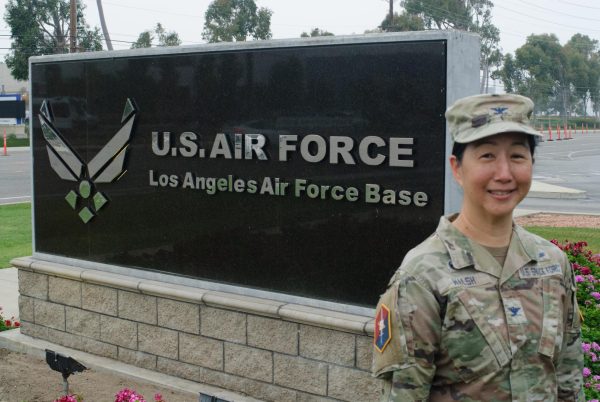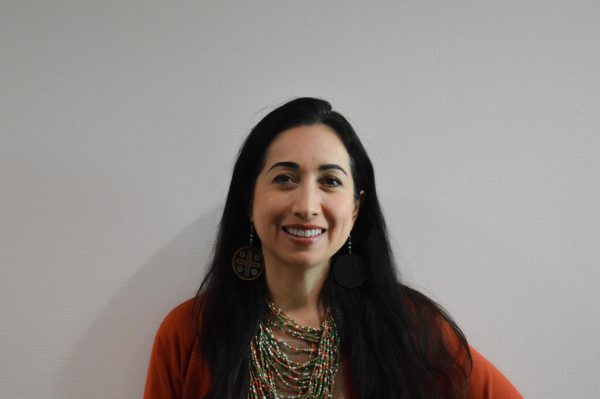Exhibit goes beyond ‘Dia de los Muertos’, celebrates Mexican and Chicano art
Musician Hector Marquez (left) assists lecturer Miriam Quezado-Hagerman (right) by giving some history for the Mexican folk song “La Llorona” at a new art exhibit at the El Camino Art Gallery on Saturday, Oct. 15. Marquez played a version of “La Patita,” a famous Mexican children’s song by children’s musical artist “Cri-Cri.” (Delfino Camacho | The Union)
Dressed in all black except for his golden brown jacket, the musician had one foot on a chair and both hands on his guitar as he spoke to the crowd.
Hector Marquez, known for his distinct Latin sounds, gave the audience a history lesson about the Mexican folk song “The Weeping Woman,” better known as “La Llorona.”
Then, with a strum of his fingers the guitar came to life.
Marquez’s spoken words transitioned into melodic Spanish lyrics. Audience members, including painters and sculptors, sang along with the musician all while surrounded by art created and inspired by the Mexican and Chicano experience.
This was the opening ceremony of Aqui y Alla y Mas, the latest exhibit on display at the El Camino College Art Gallery, which hosts a variety of art pieces created by local and international artists.
While the exhibit officially opened on Oct. 10, the gallery held a public reception on Saturday, Oct. 15.
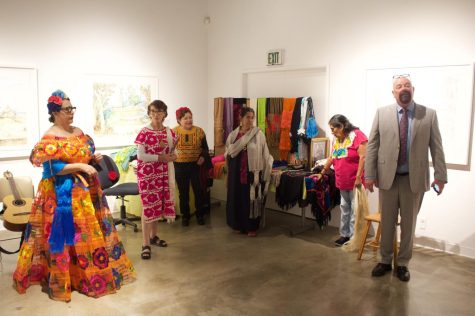
Arts Gallery Director and Curator Michael Miller said he was inspired by a previous 30-year-old art exhibit titled “Aqui y Alla.”
Miller said that the title, translated to “Here and There,” conveyed the way Mexican artists felt about Mexico and The United States. Their home is both here and there.
“My idea was very simple, originally, I wanted just to be able to present to the campus and the community viewpoints of some of the artists from the Mexican, Mexican-American, Chicano, Latino, and Latinx culture,” Miller said.
Miller came up with the theme for the show but insisted that this exhibit was a collaboration between him and fellow curator and El Camino student Dulce Stein.
Stein, who is Mexican, has deep roots in the Los Angeles art scene. The single mother of three was the curator of the Neutra Museum in Silver Lake for years before deciding to return to school.
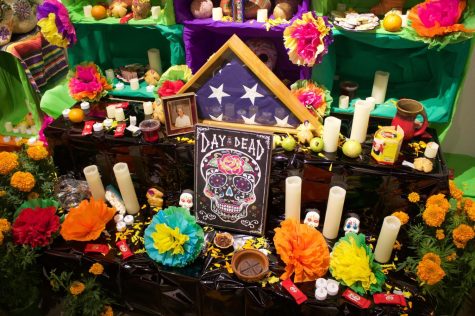
Although Stein and Miller had been Facebook friends for over 10 years, the two did not meet until she came into the gallery full of ideas.
“I walked into the gallery and I said, okay, Michael, the students would like to collaborate,” Stein said. “I wanted to represent what I know and what I know is Chicano/Latino… this is what I happen to know best, to share my culture and to learn from other cultures.”
With the theme set, Stein entered the gallery and went to work. Miller credited Stein for making the show a reality and said her relationships with the featured artists made them eager to participate.
Stein said she credits fellow organizers Mary Clarke-Camargo and Juan Varela, as well as other members of the newly formed club, Centro Cultura Oaxaca, for their hard work.
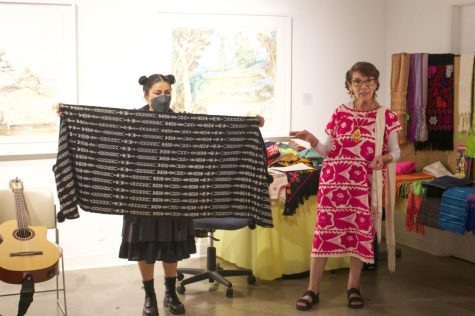
The public reception opened with a detailed historical lecture on “rebozos,” a traditional Mexican garment similar to a shawl. The item has deep meaning in Mexican culture.
The lecture was given by historian and poet Miriam Quezado-Hagerman, one of the foremost experts in the history of rebozos. As Quezado-Hagerman spoke, fellow artists and volunteers walked around modeling different rebozos.
Guests were free to explore the gallery space as the opening lecture ended.
One of the first things visitors will see is a giant mural awash in gold, silver and black shapes.
While murals have significance in the Mexican and Chicano art world, artist Zak Perez said his interest in them lies more with subliminal messages. His mural has the word “love” hidden in its abstract visuals.
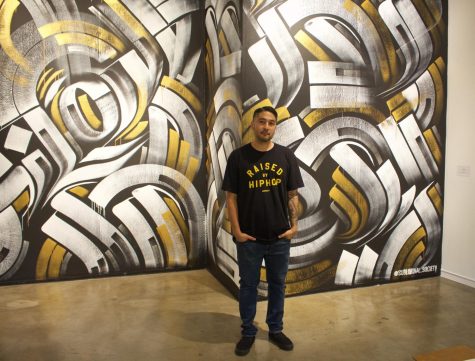
The exhibit also features a traditional “ofrenda,” or offering, a display meant to honor ancestors and the people lost on the Mexican holiday, Dia de Los Muertos.
Among the colorful candles and decorative skulls, the bright yellow petals of marigolds littered the ofrenda base in the shape of a cross.
Work from Mexican photographer Reynaldo Rivera is also in the exhibit. Rivera focuses on documenting the images and lives of Mexican and Chicano queer communities. The intimate snapshots showcase the rarely-seen corner of the LGBTQ+ community.

Artist Juan Varela focuses on highly detailed embroidery. His pieces feature recreations of both Aztec and Mayan sculptures, all done with embroidery and some acrylic and resin for the backgrounds.
Varela says he spent three years experimenting with threads to guarantee the textures and the colors he wanted. Details are essential to Varela because he hopes viewers get lost in his work.

“My pieces are books. They tell stories, the legends of the gods,” Valeria said.
Stein and other organizers insist that the Mexican experience is not singular and wanted to provide a variety of artistic mediums to also represent that idea.
Artist Gabriela Zapata whose paintings are also featured in the show said that in Spanish, the word curator has a double meaning. Besides museum keeper, the word also sounds like the term for a medicine woman, ‘curadora’.
“That’s what [Stein] is to all of us,” Zapata said in her native Spanish. “She’s an artistic healing woman.”
The exhibit is free to the public and closes on Nov. 3.




